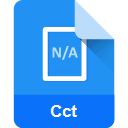.CCT File Extension

Director Protected Cast Resource
| Developer | Adobe Systems |
| Popularity | |
| Category | Data Files |
| Format | .CCT |
| Cross Platform | Update Soon |
What is an CCT file?
.CCT files, short for Director Protected Cast Resource files, are associated with Adobe Director, a multimedia authoring tool used to create interactive presentations, animations, and games. These files contain resources such as graphics, sounds, videos, and scripts, which are utilized within Director projects for creating rich multimedia experiences.
More Information.
Adobe Director emerged in the early 1990s as a successor to Macromedia Director. Its primary purpose was to enable developers to create multimedia-rich applications and presentations for various platforms, including desktop computers and CD-ROMs. .CCT files were designed to store resources securely and efficiently within Director projects.
Origin Of This File.
The .CCT file extension is specific to Adobe Director, which was originally developed by Macromedia and later acquired by Adobe Systems. It gained popularity as a versatile tool for creating interactive content for both online and offline use.
File Structure Technical Specification.
.CCT files typically store various multimedia resources, including images, sounds, videos, and scripts, in a proprietary format optimized for Director’s runtime environment. The exact structure and specifications of .CCT files are proprietary to Adobe Director and may not be publicly documented.
How to Convert the File?
Windows:
- Open Adobe Director on your Windows computer.
- Load the .CCT file containing the resources you want to convert.
- Extract the resources from the .CCT file using Director’s built-in tools or by manually exporting each resource individually.
- Once extracted, convert the resources to the desired format using appropriate software. For example, use image editing software to convert images, audio editing software for sounds, and video converters for videos.
- Save the converted files in the desired format and location for further use.
Linux:
- Install Wine on your Linux system, which allows you to run Windows applications.
- Download and install Adobe Director using Wine.
- Open Adobe Director and load the .CCT file.
- Follow the same steps as outlined for Windows to extract and convert the resources within the .CCT file.
- After conversion, save the converted files in the desired format and location.
Mac:
- Launch Adobe Director on your Mac computer.
- Import the .CCT file containing the resources you wish to convert.
- Extract the resources from the .CCT file using Adobe Director’s tools or by exporting them individually.
- Convert the extracted resources to the desired format using appropriate Mac software for image, audio, and video conversion.
- Save the converted files in your preferred format and directory for further use.
Android:
- Transfer the .CCT file containing the resources to your Android device.
- Use a file manager app to locate and open the .CCT file.
- Extract the resources from the .CCT file to your device’s storage.
- Utilize Android-compatible conversion apps or online tools to convert the extracted resources to the desired formats (e.g., images, audio, video).
- Save the converted files on your Android device for use in compatible applications or projects.
iOS:
- Transfer the .CCT file containing the resources to your iOS device, if possible.
- Use a file management app or compatible software to access the .CCT file.
- Extract the resources from the .CCT file to your iOS device’s storage.
- Utilize iOS-compatible conversion apps or software to convert the extracted resources to the desired formats suitable for iOS applications.
- Save the converted files on your iOS device for use in compatible apps or projects.
Advantages And Disadvantages.
Advantages:
- Compact storage: .CCT files efficiently store multimedia resources within Director projects.
- Integration with Director: .CCT files seamlessly integrate with Director projects, enabling easy access to resources during development.
- Protection of resources: The “Protected” aspect of .CCT files implies some level of resource protection, which can be advantageous for proprietary or sensitive content.
Disadvantages:
- Proprietary format: .CCT files are specific to Adobe Director, limiting their compatibility with other software and platforms.
- Limited documentation: Detailed specifications of .CCT file structures may not be publicly available, making it challenging for third-party developers to work with these files.
How to Open CCT?
Open In Windows
.CCT files can be opened on Windows systems using Adobe Director or compatible software capable of handling Director projects.
Open In Linux
Support for .CCT files on Linux may be limited, but they can potentially be opened using Wine with Adobe Director installed, or by extracting resources from .CCT files using alternative methods.
Open In MAC
On macOS, .CCT files can be opened with Adobe Director or compatible software designed for multimedia authoring.
Open In Android
.CCT files are not natively supported on Android devices. To utilize .CCT resources on Android, developers may need to extract and convert them to formats compatible with Android development frameworks.
Open In IOS
Similarly, .CCT files are not directly supported on iOS devices. Developers may need to extract and convert resources for use in iOS applications, adhering to Apple’s development guidelines.
Open in Others
Opening .CCT files on other platforms may require similar approaches as mentioned above, involving either Adobe Director or alternative methods for resource extraction and conversion.













